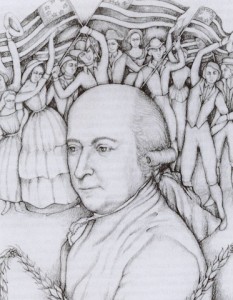|
J. William T. "Bill" Youngs, American Realities, Volume One:
Historical Episodes from First Settlements to the Civil War, Chapter Seven |
John Adams, Official Presidential Portrait, by John Trumbull, courtesy of the Wikipedia Commons
|
07. Testing the Constitution
|
Summary |
|
During the two centuries since 1776, Americans have frequently found new rights imbedded in the ideology of the Revolution, but at other times they have moved towards limiting the rights associated with the Revolution. In the struggle over the Alien and Sedition Acts, they adopted measures greatly limiting freedom of speech — contrary to the Bill of Rights. This essay explores the immediate circumstances that made those limitations seem proper. Then it traces the growth of a public reaction against the acts and argues that this opposition ultimately strengthened the First Amendment. In the story of the Alien and Sedition Acts we see the first of many episodes in which Americans would reexamine, then reaffirm, the high ground of human rights they had adopted during the era of the Revolution.
|
Author Reads From the Text
President John Adams had hoped to travel quietly from Philadelphia, the national capital, to Quincy, Massachusetts, where he and his wife, Abigail, would spend the summer. The business of preparing for war — expanding the army, building new ships, appointing officers — had left him exhausted. Abigail, too, needed rest, having followed every turn of national affairs almost as closely as her husband. She found Philadelphia’s summer air so hot and close that “you had as good be in an oven.” She missed her friends at home and now wanted to “slide along to them, unnoticed and without parade.”
As the carriage entered Newark, the good citizens of that place were more pleased to see the president than he was to see them. Undoubtedly he waved and smiled politely, but he did not stop to greet the notables who had hoped to kiss his hand. As he drove past the young men preparing to saluate him with a cannon, they chanted in unison, “Behold the chief who now commands.” The president probably acknowledged their greeting, but his carriage rattled on, leaving the youths to fire a sixteen-gun salute after their departing commander in chief.
At the doorway of John Burnet’s tavern a well-liquored crowd watched the coach as it disappeared down the road. The town’s moment of glory had ended abruptly, and there remained only the anticlimax of the day ahead. Perhaps to enliven the atmosphere, one of the men remarked, “There goes the President, and they are firing at his ass.”
In response another fellow, one Luther Baldwin, who was said to be “a little merry,” expressed his political sensibilities in a few pithy words, “I do not care,” said he, “if they fire through his ass.”
Suddenly the town had a new event at which to marvel. Here in their midst was a traitor, a speaker of forbidden words. Such, at least, was the conclusion of the tavern owner. “This is sedition,” he said. A group of Federalists who had gathered around expressed their agreement. Luther Baldwin had broken the law, and he must pay the penalty…
As the carriage entered Newark, the good citizens of that place were more pleased to see the president than he was to see them. Undoubtedly he waved and smiled politely, but he did not stop to greet the notables who had hoped to kiss his hand. As he drove past the young men preparing to saluate him with a cannon, they chanted in unison, “Behold the chief who now commands.” The president probably acknowledged their greeting, but his carriage rattled on, leaving the youths to fire a sixteen-gun salute after their departing commander in chief.
At the doorway of John Burnet’s tavern a well-liquored crowd watched the coach as it disappeared down the road. The town’s moment of glory had ended abruptly, and there remained only the anticlimax of the day ahead. Perhaps to enliven the atmosphere, one of the men remarked, “There goes the President, and they are firing at his ass.”
In response another fellow, one Luther Baldwin, who was said to be “a little merry,” expressed his political sensibilities in a few pithy words, “I do not care,” said he, “if they fire through his ass.”
Suddenly the town had a new event at which to marvel. Here in their midst was a traitor, a speaker of forbidden words. Such, at least, was the conclusion of the tavern owner. “This is sedition,” he said. A group of Federalists who had gathered around expressed their agreement. Luther Baldwin had broken the law, and he must pay the penalty…

